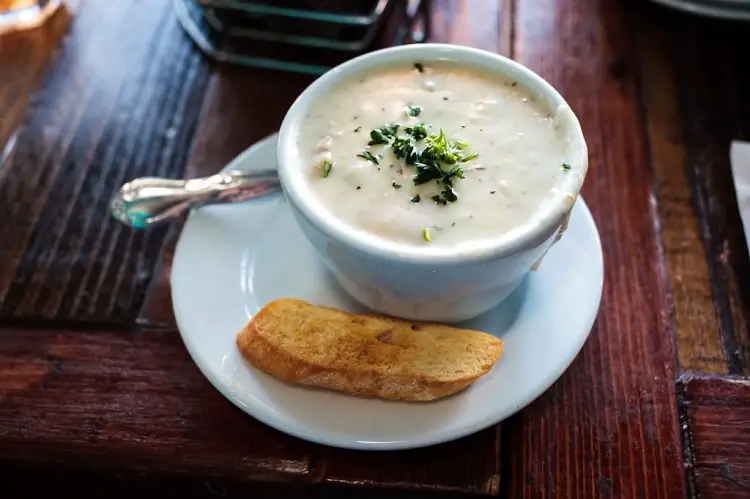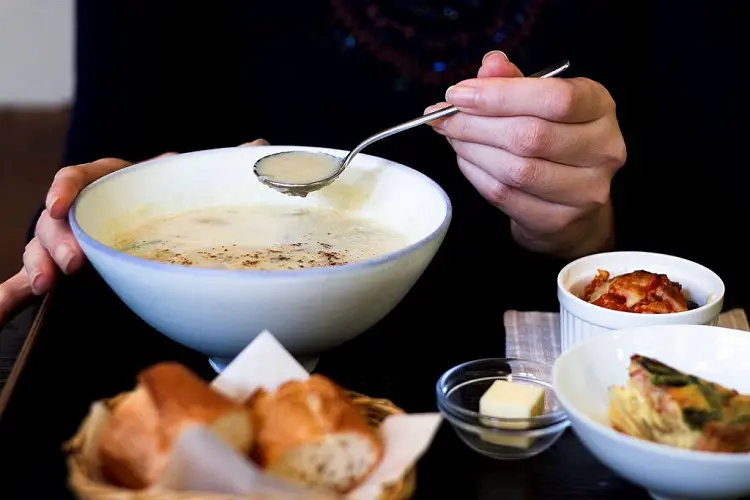As a breastfeeding mom, consuming seafood is one of the easy ways to stay healthy.
Healthy seafood options such as salmon, tilapia, catfish, sardines, canned light tuna, shrimp, crab, squid, lobster, and clams are low in Mercury and considered safe during breastfeeding.
Clam Chowder includes other healthy ingredients like salt pork and onions. For clarity, we will focus on clam chowder while breastfeeding, whether you can eat it, and how safe it is during breastfeeding.
What is Clam Chowder?
Originally from the United States, Clam Chowder is a type of soup with Clams as its primary ingredient.
It includes a base made from salt pork, bacon, or chicken and may contain other ingredients like celery, onions, and potatoes. Others use tomatoes to form the base.
No matter what other additional ingredients you include, it is nutritionally high value and offers a variety of vitamins and minerals packed in a bowl of soup.
Other ingredients used in preparing Clam Chowder include;
- Salt pork
- Onions
- Diced potatoes
- Cream or tomatoes and other leafy vegetables are optional.
Even though it appears unsophisticated, the dish is healthy and highly nutritious, and you can see it on the menu of many restaurants in the United States.
Is It Safe to Eat Clam Chowder While Breastfeeding?

Like many other uncommon foods, many people question how safe it is to eat Clam Chowder during pregnancy and breastfeeding because these are critical moments in the mother’s and child’s lives.
Before anyone else can decide if a dish is safe for you, you must consider your allergies.
And also, ask for the opinion of your OB-GYN because they are aware of your medical history and will hint you of any signals if the need arises.
However, Clam Chowder is relatively safe for breastfeeding mothers because it is organic and doesn’t support unnecessary weight gain.
Can I Eat Clam Chowder While Breastfeeding?
If you are not allergic to any of the ingredients in the soup, you should try it out from time to time.
Not only is it tasty, but it is also among some of the seafood that are lower sources of Mercury, containing less than 0.01 parts per million (ppm) of Mercury per 3-ounce portion.
To be clear on the effects of Mercury on a newborn, Mercury is a naturally occurring mineral that is insoluble and can be found in the air, water, or land.
By burning coal and fuels, it moves freely and is airborne, which means it can corrupt the system just by inhalation.
Many fishes contain Mercury since most of what they eat is contaminated by it. But some fishes have a higher level of Mercury than others, significantly bigger fishes that feast on smaller ones.
For example, sharks, tilefish, and swordfish have a higher percentage of Mercury than fishes like catfish, salmon, tilapia, shrimps, crabs, clams, lobsters, and a few others.
Since Mercury is insoluble, if it gets into the bloodstream, it can prevent proper blood flow and eventually damage the child’s brain.
And since clams are good sources of protein, Omega 3 fats, and other vitamins, they’re healthy and safe for breastfeeding moms.
Safety Precautions
Keep a few safety measures in mind when eating seafood with fish as the main ingredient.
- Even though you are likely to find Mercury in almost all fishes, not all are poisonous.
- Mercury can get to the baby through the breastmilk, and you can’t get it only from fish. You’re likely inhaling Mercury if you live in a densely industrialized zone.
- Not only Mercury contaminates other chemicals present in the sea, and it can be very dangerous to the baby. Avoid eating fish directly from a polluted waterboy.
- Try to eat a variety of dishes to get more nutrients. Limiting yourself to a type of fish will not provide the number of nutrients you require.
- Always talk to your healthcare worker or nutritionist about the foods you intend to consume.
Read Also: Can I eat pizza while breastfeeding? Explained
Alternatives to Clam Chowder
Even though your primary concern may be about eating Clam Chowder While Breastfeeding, you may wonder if there are other alternatives to use alongside the soup. After all, the more, the merrier.
Fortunately, there are other options that you can use in place of the soup to prevent it from becoming boring. Here are a few alternatives to Clam Chowder.
Linguine with mussels or oysters
Clams are rare, and even where you find them, they can be expensive depending on the location.
Irrespective, you can still use oysters or mussels; they have a close semblance in taste to clams and provide a handful of nutrients just like the original Clam Chowder.
Vegetable stock
Usually, every clam chowder requires a clam base, but if you’re out of clams, you can use vegetable stock to form your clam base and make your dish.
This is a good option for vegetarians or those planning to switch over.
Fish or Chicken stock
Both are suitable options for clam juice. If you intend to use a fish, use a less oily fish of your choice to prepare this. The exciting part is that they’re equally tasty and nutritious, just like the clams.
As many prefer this option, you can also use bacon or smoked brisket instead of clams.
Read Also: Honey mustard while breastfeeding
When Not to Eat Clam Chowder
You may wonder if there are moments when clam chowder is not advisable, just as other foods become harmful if consumed excessively.
If the clams aren’t bad and the soup isn’t contaminated, clam chowder is safe to eat except in cases where it becomes bad during preservation. Even so, there are ways to determine if the clams have gone bad and when to discontinue.
- If the cammed Clams have an abnormal smell when you open it
- If you notice any growth from the clams
- If you’ve already prepared the soup and it begins to taste sour and smell awful
- If the soup looks grey or changes color from its regular appearance.
- The soup’s smell, taste, and appearance are all three-pointers for when the soup is bad and unfit for consumption.
Read Also: Can I eat chicken curry while breastfeeding
Clam Chowder While Breastfeeding – FAQs
Can I drink clam chowder when pregnant?
It is safe for pregnant women to eat clams as long as they are cooked thoroughly.
Undercooked or raw clams can harm pregnant women’s health when consumed in chowder. Pasteurized milk, cream, and clams may also be harmful.
What seafood can you not eat while breastfeeding?
According to the CDC, sharks, swordfish, tilefish, and king mackerel are the exceptions and foods to avoid while breastfeeding.
You should avoid eating older, top-predator fish while breastfeeding since they contain the highest levels of Mercury.
Does seafood pass through breast milk?
International Board Certified Lactation Consultant Anne Smith explains that all foods can pass through breast milk within 4-6 hours after you eat them, but sometimes it may take as little as one hour or as long as 24 hours.
What is the difference between clam chowder and New England clam chowder?
The difference between New England chowder and other regional styles is that New England chowder is milk or cream-based, which makes it significantly thicker, and it is usually accompanied by oyster crackers, butter, potatoes, pork, onions, and clams.
Can I eat cooked seafood while breastfeeding?
According to the U.S. Environmental Protection Agency (EPA), pregnant and breastfeeding women should consume 2 to 3 servings of seafood, which amounts to about 8 to 12 ounces. You must consume a variety of seafood (230 to 340 grams) every week.
Conclusion
If your initial question was can I eat Clam Chowder While Breastfeeding, you might as well begin to wonder how much of it is too much because of how addictive it can be for seafood lovers. It’s still important to include some protein and Omega 3 in your meals, even if you don’t like seafood.
